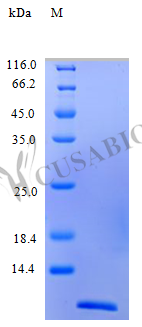This Recombinant Human CCL26 protein is an essential research tool for investigators in the field of immunology. This C-C motif chemokine 26, also known as CCL26, is expressed in E. coli, featuring the 24-94aa expression region of the full-length mature protein. The tag-free protein is supplied as a lyophilized powder, allowing for easy reconstitution with sterile water or buffer to facilitate a wide range of experimental applications.
Quality and performance are paramount for us, and our Recombinant Human CCL26 protein exhibits a purity of >97% as determined by SDS-PAGE and HPLC analysis. In addition, endotoxin levels are maintained below 1.0 EU/µg, as assessed by the LAL method. The protein demonstrates full biological activity in a chemotaxis bioassay using human CCR3 transfected HEK293 cells, with an effective concentration range of 0.5-2.0 μg/ml.
Over the years, numerous studies have explored the role of CCL26 in immune regulation. For instance, Garcia-Zepeda et al. (1996)[1] initially identified CCL26 as an eosinophil-selective chemoattractant, and Komiya et al. (2003)[2] later highlighted its role in allergic inflammation. Subsequently, Abonyo et al. (2010)[3] showed that CCL26 contributes to eosinophil trafficking in the airways, and Ying et al. (2012)[4] linked CCL26 with asthma pathogenesis. Taken together, these studies emphasize the importance of CCL26 in the immune system and its potential as a therapeutic target for immune-related diseases.
References:
1. Garcia-Zepeda EA, et al. Human eotaxin is a specific chemoattractant for eosinophil cells and provides a new mechanism to explain tissue eosinophilia. Nat Med. 1996;2(4): 449-56.
2. Komiya A, et al. CCL26/eotaxin-3 is more effective to induce the migration of eosinophils of asthmatics than CCL11/eotaxin-1 and CCL24/eotaxin-2. J Leukoc Biol. 2003;74(4): 611-7.
3. Abonyo BO, et al. Human eotaxin-3/CCL26 gene expression is regulated by DNA demethylation. Clin Exp Allergy. 2010;40(8): 1254-63.
4. Ying S, et al. Expression and cellular provenance of thymic stromal lymphopoietin and chemokines in patients with severe asthma and chronic obstructive pulmonary disease. J Immunol. 2012;181(4): 2790-8.




